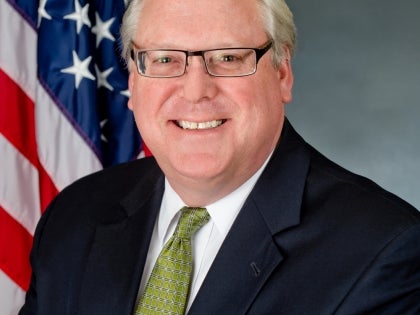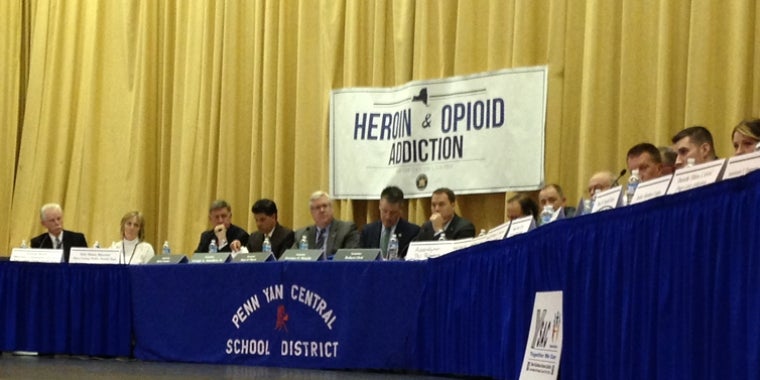
O’Mara joins colleagues on Senate Task Force on Heroin to release report, recommendations: 4-pronged strategy focused on prevention, treatment, recovery, enforcement ~ Read more
May 17, 2016
-
ISSUE:
- Heroin and Opioid Addiction

Albany, N.Y., May 17—State Senator Tom O’Mara (R,C,I-Big Flats), a member of the Joint Senate Task Force on Heroin and Opioid Addiction, today joined the task force co-chairs and other members to release a comprehensive report detailing a series of recommendations for state-level actions to further address the burgeoning heroin and opioid addiction crisis impacting communities across the Southern Tier and Finger Lakes regions, and statewide.
The Senate is scheduled to act on a number of the recommendations in session later today.
The Senate report follows a series of public forums the heroin task force held across the state throughout the past year. O’Mara sponsored a forum at the Penn Yan Middle School in Yates County in February.
“What the Senate task force heard directly from the local front lines in fighting this heroin crisis is the foundation we’re building on. This local input, which has been reflected in actions we’ve taken over the past several years as well as in this year’s state budget, helps us target the necessary responses and will keep our strategies as up to date as possible,” said O’Mara. “Heroin is devastating lives in Penn Yan, Hornell, Ithaca, Elmira and many other communities throughout the Southern Tier and Finger Lakes regions, and statewide. Local input has been the driving force behind the recommendations we’re putting forth now to build on and strengthen the state-local partnership that's going to be critical to putting in place the most effective combination of law enforcement, awareness and education, and treatment and prevention. We need to keep acting and keep working, and we will."
The bipartisan Senate task force was created in 2014 at a time when local police departments and addiction centers, including many across the Southern Tier and Finger Lakes regions, were pointing to the alarming rise in the availability and use of heroin. In addition to the forum earlier this year in Yates County, O’Mara also brought the task force to Elmira in 2014.
O’Mara and his colleagues unveiled their latest recommendations at a news conference at the Capitol today. Their report proposes recommendations gleaned from testimony from regional law enforcement officers, first responders and district attorneys, drug addiction counselors and treatment providers, recovering addicts and family members, social services and health professionals, educators and other experts about the range of complex challenges posed by heroin including addiction prevention and treatment options, drug-related crimes, and other community and public health and safety impacts.
The legislative package, which O’Mara will co-sponsor, together with funding in this year’s state budget, seeks to build on existing state-level laws, programs and services enacted over the past few years to strengthen awareness, education, prevention and treatment efforts.
But it also takes further aim at heroin traffickers and dealers, including legislation (S4163) to allow law enforcement to charge a drug dealer with homicide, a class A-1 felony carrying a penalty of 15-25 years in prison, if a person dies of an overdose of heroin or other opiate-controlled substance sold by that dealer. The measure targets mid- to high- level drug suppliers who profit from heroin sales.
“Awareness and education, prevention and treatment are the fundamental responses. But so are tough laws and law enforcement, especially when it comes to heroin traffickers and dealers. I agree that we can’t arrest our way out of this crisis, but we shouldn’t hesitate to throw the book at the pushers and suppliers of this deadly drug,” said O’Mara.
Other specific recommendations which O’Mara co-sponsors and that the Senate will begin acting on today -- and will push to see enacted into law before the conclusion of the current legislative session – include measures to:
> expand the crime of operating as a major trafficker (S4177) to more accurately reflect the nature of the criminal enterprises and increase successful prosecutions. The bill recognizes the low street prices of heroin by lowering the minimum required proceeds from the sale of controlled substances during a 12-month period from $75,000 to $25,000;
> facilitate the conviction of drug dealers (S100) by allowing someone to be charged with a felony crime of intent to sell if they possess 50 or more packages of a Schedule I opium derivative, or possess $300 or more worth of such drugs. Under current law, dealers can carry large quantities of the drug before triggering a felony charge of possession;
> establish assisted outpatient treatment for substance use disorders (S631). Courts would be enabled to order assisted outpatient treatment (AOT) for an individual with a substance use disorder who, due to his or her addiction, poses a threat to him or herself or others;
> authorize the commissioner of health to establish standards, and review and implement requirements for the performance of continuing medical education on pain management, palliative care and addiction (S4348);
> require credentialed alcoholism and substance abuse counselors (CASAC) to complete training in medication assisted treatment as part of their continuing education requirement (S7301);
> require the commissioner of health to report data on opioid overdoses on a county-by-county basis (S6516A). The state has begun to make opioid antagonists, such as Narcan, available over the counter. However, how often opioid antagonists are being administered to revive individuals is severely underreported. Without accurate information about how many reversals are happening, it is difficult to determine the amount of resources a community needs;
> establish the class B felony of criminal sale of a controlled substance upon the grounds of a drug or alcohol treatment center (S7200);
> require pharmacists dispensing an opioid to include a pamphlet with warnings relating to the risks of using such controlled substances (S7315);
> require patient counseling before a practitioner issues a prescription for a schedule II opioid (S7365), specifically to consult with a patient concerning the quantity of an opioid prescribed as well as the patient's option to fill the prescription in a lesser quantity. The patient would also have to be informed of the risks associated with an opioid-related addiction; and
> establish protocols for assisted outpatient treatment for substance abuse (S631).
Overall, O’Mara and his task force colleagues are focused on a four-pronged approach to the crisis:
1.) Prevention by increasing awareness to better educate the public of the inherent risks involved in using heroin and prescription opioids, and taking advantage of technological advances available to deter the abuse of prescription drugs and prevent addiction;
2.) Treatment through the recognition of the critical need for expanded and improved insurance coverage, and enhancing access to all forms of effective treatment - including inpatient, outpatient, and Medication Assisted Treatment - in order to help individuals return to stable and productive lives;
3.) Recovery by providing the proper supports, such as safe environments, stable employment, and opportunities to participate in diversion programs that avoid incarceration in order to facilitate successful recoveries from addiction; and
4.) Enforcement by implementing criminal justice reforms that give law enforcement the necessary tools to disrupt the supply of heroin and stop the diversion of opiate prescription medications within the state.
In addition to the highlighted legislation above being acted on by the Senate today, O’Mara said that the Task Force report puts forth the following, comprehensive recommendations for legislative action this session and for state agencies to assist in implementing:
Prevention:
• Limiting initial prescriptions of controlled substances (S6091B)
• Creating a Prescription Pain Medication Awareness Program (S4348A)
• Enhancing patient access to abuse-deterrent technology for opioids (S6962A)
• Ensuring proper opioid education to prescribed patients (S7315)
• Establishing a Narcan kit registry (S6516A)
• Providing instruction of mental health, alcohol, drug and tobacco use in junior and senior high schools (S5546A)
• Requiring patient counseling prior to issuing a prescription for a schedule II opioid (S7365)
• Increasing availability of naloxone (S6346A)
• Requiring the state Department of Health (DOH) and the state Office of Alcoholism and Substance Abuse Services (OASAS) to examine and report on the underreported and at-risk populations, including but not limited to Native American Tribes and the effect the heroin and opioid crisis is having on those populations.
Treatment:
• Continuing education for credentialed alcoholism and substance abuse counselors (S7301)
• Removing barriers to Medication Assisted Treatment (MAT) (S7317A)
• Examining insurance coverage for medications approved by the FDA for use in MAT of opioid addiction and examine the accessibility across the state to new treatment modalities;
• Enhancing emergency intervention procedures (S6248B)
• Establishing assisted outpatient treatment for substance use disorders (S631)
• Requiring the DOH and OASAS to examine and report on the most effective treatment modalities, including ideal settings, treatment length, and best practices for heroin and opioid addiction
• Creating and appointing an Ombudsman to assist individuals and families in obtaining appropriate insurance coverage for treatment services
• Requiring all OASAS-certified treatment providers to inform individuals receiving treatment and their families of their right to file an external appeal with the Department of Financial Services (DFS) and provide them with the means necessary to access such appeal
• Requiring DOH and DFS to rigorously scrutinize the implementation of any conditions placed on accessing treatment.
Recovery:
• Including for-profit providers in the Request for Proposals Process for substance use disorder and gambling programs (S7446)
• Creating a Sober Living Task Force (S3989A)
• Expanding treatment options for judicial diversion participants (S6874)
• Expanding access to judicial diversion programs (S6322A)
• Encouraging employment of recovering users (S2346)
• Enacting the Wraparound Services Demonstration Program (S7748A)
• Requiring DOH and OASAS to examine and report on vital statistics related to heroin and opioid addiction, including relapse rate, length of treatment, and what, if any, follow up care supports are in place upon discharge.
Enforcement:
• Facilitating the conviction of drug dealers (S100)
• Expanding the crime of operating as a major trafficker (S4177)
• Creating Drug-Free Zones around drug or alcohol treatment centers and methadone clinics (S7200)
• Establishing appropriate penalties as it relates to heroin sales (S7012)
• Enhancing judicial access to juvenile records for determining judicial diversion program eligibility (S6317)
• Adding fentanyl to the controlled substance schedule (S6632A)
• Establishing Xylazine as a controlled substance (S7397)
• Creating the crime of homicide by sale of an opioid controlled substance (S4163)
• Developing a formula to dispense funds acquired from the seizure of assets used in the commission of drug crimes.
The full report with detailed findings and recommendations can be found at: https://www.nysenate.gov/sites/default/files/articles/attachments/htf_report_final_5.17.16.pdf
O’Mara also stressed that the 2016-2017 state budget includes $166 million in funding to continue enhancing and expanding the state’s heroin and opioid addiction prevention, treatment, recovery, and education services. He said the budget mirrors the actions the Senate first proposed in its one-house budget resolution in early March. How best to distribute and utilize this funding remains one of the key agreements that must be reached between the Legislature and Governor Andrew Cuomo before the end of the current legislative session.
The budget also includes $1 million for the state Department of Environmental Conservation (DEC) to maximize the availability of drug collection programs in communities statewide, including to local law enforcement agencies. The program will include the purchase and distribution of tamper-proof drug collection boxes and other federally approved drug collection programs to help protect the environment from harmful substances and reduce the risk of addiction through the safe and responsible disposal of opioid pharmaceutical drugs.



